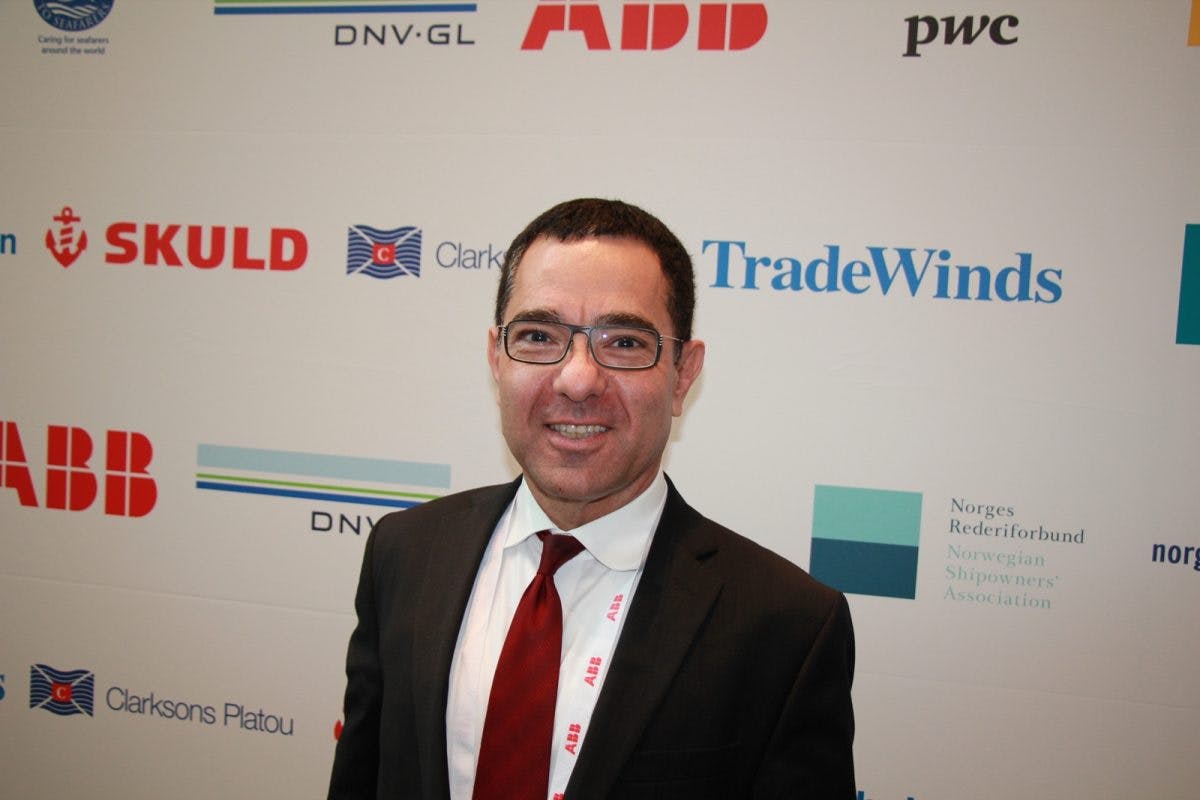Tony Seba: Norway must do the math: If you can’t compete at $25 a barrel, you are out!
The main message from Tony Seba: Oil demand will peak in 2020 and disruption in the transportation sector will take away 30 million barrels per day from oil demand over the next decade. Oil more expensive than $25 a barrel will be uneconomic and stranded.

Tony Seba says the transportation sector will be disrupted with reduced oildemand as a result. (Foto: Henrik Tveter)
Tony Seba, a lecturer at Stanford University, expert on disruptions in the energy and transportation sectors and speaker at the Nor-Shipping conference in Oslo this week, is the co-author of the new report from RethinkX, Rethinking Transportation 2020–2030. The report is about the disruption that is due in the road transportation sector. I met him at the Nor-Shipping conference, where we sat down to talk about the report and the implications for the future of Norway’s oil and gas sector. He says that Norway needs to «do the math» for oil and energy when it comes to positioning itself as an energy nation going forward.
Energi og Klima: – Tell us about the main findings from your new report?
Tony Seba: – Essentially the main finding is that from the day autonomous vehicles (AVs) are approved for public roads it will take ten years for 95% of all passenger miles to be driven by autonomous electric vehicles (AEVs). 95% of road travel will be autonomous, electric and shared. This means that two things will be disrupted, one is the individual ownership of cars and the other one is the internal combustion engine automobile.
Seba introduces the term transportation as a service (TaaS) in his new report. In the future he argues, we will no longer own our cars, but buy transportation as a service, from fleets of autonomous electric vehicles (AEVs) owned by companies – not individuals.
– Ten years seems like a short time for a transition to 95% of passenger miles being serviced by fleets of AEVs. How do explain the speed of deployment? What about barriers such as already paid off cars?
– Some say a transportation disruption cannot happen within 10 years. There are a couple of things to address here. One, Uber today has more bookings than the entire US taxi industry. Uber did not exist in 2008. This happened in 8-9 years, so disruptions in transportation do happen in ten years. The other one is that this is called a big bang disruption. This means that on the day autonomous vehicles are approved, transport as a service, which is electric autonomous vehicles operating in fleets and on demand, will be ten times cheaper than buying a new car. Every time there has been a factor of ten difference in cost, in any product or service in history, there has been a disruption. People are going to stop buying cars. We spend around 10 000 dollars a year on car ownership. We will be able to get the same level of transportation for 1000–2000 dollar. It makes rational economic sense to change your behavior. People will save 7, 8 or 9000 dollars. Who would not want to do that? Also, even if you own a car that is already paid off, so that all you need to do is to pay for petrol, maintenance and operating costs, that is still going to be 2-4 times more expensive than transport as a service. So even if somebody gives you a car for free, the running costs will be 2-4 times more expensive than transport as a service. This means that no one will buy a new car, and those who own a car, once they get rid of their car, they are not going to buy a new one, because at that point the differential in cost will increase. The cost of transportation as a service will keep going down and the cars for private ownership will keep going up. So over time it will make even more sense to get rid of your car and get into transport as a service.
– You say in your report that oil demand will peak in 2020 and that this transportation disruption alone will take away 30 million barrels per day from oil demand. How should the oil and gas exporting country, Norway, position itself in this transition to the low carbon economy?
– First of all, this is not about carbon, it is about economics. The economics of transport as a service is going to drive this disruption. The effect will be that carbon emission from road transportation will go down by 95%, but this is not driven by carbon or climate change, it is driven by the economics. Our finding is that oil demand will peak at 100 million barrels per day in 2020, and then fall to 70 million barrels per day by 2030. So demand for oil will fall over ten years, but the oil price is going to collapse immediately, as soon as 2021. Why is that? All you need in an oil market is an imbalance in supply and demand of about 2 million barrels per day. We saw that in 2014, when 2 million barrels oversupply caused the oil price to collapse. The equilibrium cost in the oil market where demand is 70 million barrels per day is 25 dollars per barrel. So essentially, if you cannot compete at 25 dollars per barrel, you are out. So all the assets based on uneconomical oil are going to be stranded. Countries with conventional oil like Saudi-Arabia and Russia will be able to compete because their production cost are way below 20 dollars per barrel. But if you cannot compete at 20–25 dollars per barrel, then essentially your assets are going to be stranded. Our findings indicate that 70% of deep water oil, shale oil and oil sands are going to be uneconomical. These resources could be stranded as soon as 2021.
– In Norway, the government is opening up new areas for exploration in the Barents Sea, with potential production start around 2030. What advice would you have for the government in setting the policy for the development in these new fields?
– Is the Barents Sea deep-water, and what is the projected break-even prices for these new fields?
– The Barents Sea is relatively shallow water, but far north, with rough weather during the winter and long distances to shore – optimistic break-even cost would be at around 30 dollars per barrel.
– I don’t know, maybe the Norwegian government likes losing money. Essentially if you cannot compete with production costs in the 20s dollar per barrel territory, you are losing money. There is going to be an oversupply for a long time. The oil industry has gone through many ups and downs and the folks in the industry are saying that if history is an indication this will just be a preliminary fall and then we’ll be back up. The fact is that once transport as a service happens, the price of oil is not coming back up. Essentially what this means is that anything that cannot compete in the 20s dollar per barrel will be uneconomical and stranded. And this is just the beginning of the transport as a service disruption, it is going to keep going with trucking, buses, tractors, ships and so on and so forth, so oil is not coming back up.
– One of Norway’s biggest companies is an oil company, namely Statoil. What advice would you have for them when it comes to positioning itself going forward?
– Well look, the core business of Statoil is oil. Oil is going to be disrupted. So the question is: what is the best use of the assets, the people and the cash that Statoil has? So that is a discussion that they need to have. They have a few options, one is to sell the company while the market still adjusts and is in denial. Another option is to sell the high cost assets, so all the deep water, shale and oil sands that are going to be stranded. Then you should get as much cash as possible from the existing assets as long as you can. But any new investments that go into non conventional oil fields, and not just fields but also refineries and pipelines associated with high cost fields, are essentially going to be stranded. So what do you do with the cash? Is Statoil the best company to invest in clean energy? I don’t know. There are a lot of clean energy companies that have been doing this for a long time and they are very good at it. Does Statoil have the skills and market knowledge to invest in clean energy? I don’t know.
– In Norway the government is taking on most of the economic risk in developing new oil fields. What general advice would you give the government when it comes to setting the policy for new oil development?
– Essentially I think the government should stay out of the energy business. That is my general belief. Risking tax payer money in energy projects that is going to be disrupted is not a good idea. There is another disruption that is happening in parallel to transportation, namely energy, with prices of solar, wind and batteries falling sharply.
So both transportation and energy are being disrupted at the same time.
Energy is becoming more decentralized, with energy users such as people, farmers and businesses going 100% renewable. The government should let the market work. There should be fair regulation for competition, but they should get out of the energy business.
– The IEA just came out with a report that advices Norway to continue to develop oil and gas fields and associated infrastructure. How do you see their advice to Norway?
– I don’t see why anyone would listen to IEA’s advice. If you look at their predictions for solar and wind deployment going back 10-20 years, they have been wrong every single year, not just by a little bit, but by orders of magnitude. So I don’t know why anyone would pay attention. The Norwegian government should look at the real economics. Look at the cost of batteries, look at the cost of wind and solar and look at the trend line. Solar is going down by 11% per year. Battery cost has fallen by 20% per year since 2010. The cost will keep going down. Basically, do the numbers yourself. Look at the technology cost curves. Make your own decisions, based on the numbers and the reality of the current development. Do the math.
